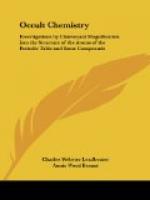GOLD: Upper part
{
12 funnels of 97 atoms 1164
{
Central ovoid {c 101
{2
d, 38 76
Lower part same
1341
Connecting rod
{ 4 a 84 336
{16
b 33 528
——
Total
3546
——
Atomic weight
195.74
Number weight
3546/18 197
It may be noted that the connecting rod is made up
of exactly sixteen atoms
of occultum, and that sixteen such atoms contain 864
ultimate atoms, the
exact member of atoms in titanium.
* * * * *
III.
Occultum was observed by us in 1895, and, finding that it was so light, and so simple in its composition, we thought that it might be helium, of which we were unable, at the time, to obtain a sample. When, however, helium itself came under observation in 1907, it proved to be quite different from the object before observed, so we dubbed the unrecognised object Occultum, until orthodox science shall find it and label it in proper fashion.
OCCULTUM (Plate VI, 1).
We here meet the tetrahedron for the first time, with each angle occupied by a six-atomed group, the atoms arranged as on the end triangles of a prism. This form recurs very often, and was noted, last month, as seen in copper (Plate VI, 3); it revolves with extreme rapidity around its longitudinal axis, and looks like a pencil sharpened at both ends, or a cigar tapering at both ends; we habitually spoke of it as “the cigar.” It appears to be strongly coherent, for, as will be seen below, its six atoms remain attached to each other as meta-compounds and even when divided into two triplets as hyper-compounds, they revolve round each other.




